.NET Sql Authorization Manager is an authorization manager for .NET Framework 2.0 developed applications (smart-client/web). The authorizations storage is MS Sql Server 2000/2005. NetSqlAzMan has been developed with Tdo - Typed Data Object technology.
What NetSqlAzMan is Its name is definitely colourful but it's neither a super-hero, not a recommended tooth-paste from the best Italian dentists J. NetSqlAzMan is the .NET Sql Authorization Manager short form and is an applicative authorization manager, that is, given an application user, what this user is authorized to do within that application. NetSqlAzMan is for all Microsoft .NET 2.0 developers that need to manage loosely-coupled applicative authorizations, that is, weakly coupled with source code, in a light and fast way having all these authorizations in a relational database such as MS Sql Server (2000/MSDE/2005/Express). For all of you who already knows MS Authorization Manager (AzMan) or ADAM (Active Directory Application Mode) then you are in the right place ... but you have to expect a lot of innovations.
NetSqlAzMan is Open Source NetSqlAzMan is an Open Source project, accommodated by the SourceForge.net community. From the following link it's possible to download both the source code (C#.net) and the setup package (.MSI) for the Win32 platform: http://netsqlazman.sourceforge.net.
Requirements
Windows 2000/XP/2003
.NET Framework 2.0 (http://msdn.microsoft.com/netframework/downloads/updates/default.aspx)
MMC (Microsoft Management Console) 3.0 (http://www.microsoft.com/downloads/details.aspx?familyid=61FC1C66-06F2-463C-82A2-CF20902FFAE0&displaylang=it)
Sql Server 2000/MSDE/2005/Express (http://msdn.microsoft.com/vstudio/express/sql/download/)
Security within the applications When we talk about applicative security it's possibile to write symbolically the following expression: { Security } = { Authentication } + { Authorization }
where for Authentication we mean the credentials phase (who are you?) and for Authorization, what a user is granted to do and what he isn't (what can you do?). Generally, the authentication moment happens at first, and it's enough to assess once the user credentials to avoid repeating every time (at run-time) the same operation (think the "logon" moment on your pc). The second phase supposes that the user credentials have already been verified and therefore the user identity is "assessed" and "well-known". At this point, the Authorization system is able to reply to a user request to execute a determined operation, for example, retrieving all the necessary information from any data source (for example File System's ACL ). To do an example, you can think when you go to the airport to take a flight. When you are at the Check-In, you are asked of an airplane ticket and an identity document so that you can have a security ticket back, the "boarding pass" (Authentication). At this point, and only after having got the boarding pass, you can go to the right exit of your flight. Once, inside the boarding zone, you aren't authorized to take any flight but exclusively the one indicated on the boarding; such rule is completed at the boarding moment (Authorization) and only with the right "ticket". I excuse myself if this example has turned out banal but it's very important to do clarity, in order to understand in which context NetSqlAzMan is placed. Well, NetSqlAzMan is just what stores and preserves the authorizations, giving us an answer like "yes, authorized" or "no, not authorized" to anyone that makes a request (applications).
NetSqlAzMan is leaned instead on MS Windows operating system in order to carry out the authentication phase (Kerberos / NTLM).
We try to understand with a concrete example, the mechanism of the authorizations in an applicative context. We imagine a managerial application of any Company. Inside this Company we can identify some "Business Roles" such as: the administrator, the leaders, the secretaries, the employers etc. and some "Applicative Roles" that is groups of persons that can do the same operations in that Application. Suppose that the application ,you are writing, has functions about business accounting management, warehouse management and so on.
This application has to work with different user levels. As example, consider the "view - end-year budget" function, that lists in detail all the costs and revenues of an entire year of activity. It's reasonable to say that such operation must be granted only to the company administrator and maybe to some leaders but not to the employers. Moreover it's reasonable to think that the administrator or one of his leaders wants "to delegate" this operation to one of his secretaries, or grant (temporarily) the permission for such operations. Now, how it's possible to realize such an application, without "wire" the following instructions inside the source code:
If (user = "Jack" or user = "Michael") then
(authorized)
Else
(not authorized)First of all, we should separate the "single customer" from the "group of customer" idea, that is, a set of users to which an operation will be granted. At design time, we'll decide which user will belong to which group:
If (user belongs to "Administrators" group) then
(authorized)
Else
(not authorized)So we are introducing a too strong association between "groups" and what "they can do". What will happen if tomorrow we decide to move a function from one group to another?!
Then we try to operate another process and say:
If (user has been authorized to do that X operation) then
(authorized)
Else
(not authorized)You're doing now the easiest thing , that is, to ask yourself if that user can or cannot do such function, without taking in consideration his name or his group/role. The only link aspect between the application and the authorizations repository is the process name. All these names together defines "a contract" and, this is binding; if you change a process name in the application or in the repository, it's necessary to change its name in the other part, too. The unique user identification is provided by the Authentication system (Windows), while the Authorization system will answer "yes" or "no" to the "he has been authorized to do that X operation" question. It's therefore necessary to have a table with the "process name" and the relative "yes" or "no" for each user/group in any repository. The NetSqlAzMan repository is called Storage and is hosted by a Sql Server database (the setup package contains the Sql Script for both 2000 and 2005 version).
Ms Authorization Manager (AzMan) vs .NET Sql Authorization Manager (NetSqlAzMan)
As pointed out before, an analogous Microsoft product already exists and is called Authorization Manager (AzMan); AzMan is present, by default, in Windows Server 2003 and, through the Admin Pack setup, in Windows XP.
The important difference between AzMan and NetSqlAzMan is that the first is Role-based, that is, based on the belonging - Role concept and the operations container in each role, while the second is Item-based (or if you prefer Operation-based), that is users or users group or group of groups that can or cannot belong to Roles or execute such Task and/or Operations (Items).
Here the most important features and differences between the two products:
Ms AzMan:
It's COM.
It's equipped by a MMC 2.0 (COM) console.
Its storage can be an XML file or ADAM (Active Directory Application Mode - e un LDAP).
It's role-based.
It supports static/dynamic applicative groups, members/not-members.
Structure based on Roles -> Tasks -> Operations. (Hierarchical Roles and Tasks , none Operations).
Authorizations can be added only to Roles.
It doesn't implement the "delegate" concept.
It doesn't manage authorizations "in the time".
It doesn't trigger events.
The only type of authorization is "Allow". (to "deny" it needs to remove the user/group from his Role).
It supports Scripting / Biz rules.
It supports Active Directory users/groups and ADAM users.
NetSqlAzMan:
It's .NET 2.0.
It's equipped by a MMC 3.0 (.NET) console.
Its storage is a Sql Server database(2000/MSDE/2005/Express).
It's based on Tdo - Typed Data Object technology.
It's Item-based.
Structure based on Roles -> Tasks -> Operations. (all hierarchical ones).
Authorizations can be added to Roles, Task and Operations.
It supports static/dynamic applicative groups, members/not-members.
LDAP query testing directly from console.
It's time-dependant.
It's delegate-compliant.
It triggers events (ENS).
It supports 4 authorization types:
1. Allow with delegation (authorized and authorized to delegate).
2. Allow (authorized).
3. Deny (not authorized).
4. Neutral (neutral permission, it depends on higher level Item permission).
Hierarchical authorizations.
It supports Scripting / Biz rules (compiled in .NET - C# - VB - and not interpreted)
It supports Active Directory users/groups and custom users defined in SQL Server Database.
The NetSqlAzMan structure You see the following structure both in the Storage and visually when you open the console (Start - run - "NetSqlAzMan.msc") :
Storage Sql Server (db)
A. Store 1 (logical)
a. Store Groups (Basic/LDAP, members/not-members)
1. Store Group 1
2. Store Group 2
b. Application 1
1. Application Groups (Bbasic/LDAP, members/not-members)
a. Application Group1
b. Application Group2
2. Item Definitions
a. Role Definitions
Role 1
b. Task Definitions
Task 1
c. Operation Definitions
Operation 1
3. Item Authorizations
a. Role Authorizations
Authorizations for Role 1
b. Task Authorizations
Authorizations for Task 1
c. Operation Authorizations
Authorizations for Operation 1
c. Application 2
...
B. Store 2
..
Store and Store Group
About Store we mean a logical grouping of applications. At this level it's possibile to define two object types: Store Group and Application.
Store Groups are applicative groups of: Windows Users/Groups, other Store Groups (such as COM+ roles or Windows security groups); each group can be Basic or LDAP type, that is, statically defined, by direct selection, or dynamically defined through a LDAP query, that NetSqlAzMan resolves at run-time. In this way it's possible, for example, to create an Active Directory users group with a name that begins with "Andrea" and Dial-In permissions. In picture 1 we see how to create a Store Group; in print 1 there is a LDAP query example and in picture 2 how to execute that LDAP query directly from NetSqlAzMan console.
Picture 1:
Picture 2 Moreover, the "Basic" Groups are constituted by Members and Not-Members that is users/groups/Store Groups that must be "considered" when creating the Store Group while the not-members are users/groups/Store Groups that must not be considered. In other words, the members list that get part of a Basic group is given by { Members } - { Not-Members}. Since that members/not-members can be, at its turn, others Store Group, it's possible to realize powerful and complex recursive groups. In pictures 3 and 4 we see the Members and Non-Members definition of one Basic group.
Picture 3:
The Store Groups have a restricted visibility at Store level, so to be visible from all the Applications contained in the Store.
Picture 4: The Store Group is the ideal in order to implement the concept of "Business Role" that is a grouping of persons in a Company who carry out one determined function with different rights from the rights that every role will have in every application; here some examples of business roles: "Managing", "Employees", "Responsible UO", etc....
Print 1:
LDAP query to include all the Active Directory users whose name begins with Andrea and Dial-In permissions.
(&(objectCategory=user)(cn=Andrea*)(msNPAllowDialin=TRUE))For all of you interested to know more about the syntax and potentiality of LDAP queries can read this interesting Microsoft article about the LDAP queries syntax: http://www.microsoft.com/technet/prodtechnol/exchange/2003/insider/ldapquery.mspx.
Application and Application Group For Application we mean that one that will request at run-time the NetSqlAzMan storage; here the definition is purely logical and so it doesn't require any association with the type or name of the real application. To avoid any confusion it's better to assign the same name and maybe writing a little description about what the application does in the appropriate gap as pictures 5 and 6 show.
Picture 5 : An Application Group is identical to a Store Group except that its scoping (visibility) is restricted only for the Application where is defined; an Application Group may consider a Store Group among its members/not-members but the vice versa cannot never happen. The Application Group is the ideal to represent "Applicative Roles".
Picture 6:
Item Definitions Every Application contains the definition of Item. Item contains the types Role, Task and Operation
Logical meanings of items type are defined as follow:
Role: is a group of "users" that can do the same operations;
a. A Role can have members type such as Role, Task, Operation.
b. Samples of Role are: "Administrator", "General Director", "Product Manager".
Task: is a logical macro-functionality of the Application
a. A Task can have members type such as Task, Operation.
b. Samples of Task are: "Insert", "Update", "View Report".
Operation: is a micro- functionality of the Application
a. An Operation can have only Operation members type.
b. Samples of Operation are: "Add new user", "Update user", "View Report 1".
It usually happens that doing a certain operation, it automatically implies doing other ones of a lower level, or this idea can be used to assign authorizations in a hierarchical way. If we consider, just as an example, "Delete" and "Insert" operations and assume that a users group is authorized to "delete", another one can "insert" and other groups are authorized to both "delete" and "insert". In this case is necessary to create a "Modify" Task and two "Insert" and "Delete" Operations therefore change the Task properties(from the console) and say that it's constituted by two Operations (members Item). This fact will be important when you'll assign authorizations to these Items, because the Task rights (container Item) will be inherited from Operation (Item members) but the vice versa will not happen (towards bottom); the one that will be authorized to "modify" will be implicitly authorized to "insert" and "delete" too. In picture 7 there's a sample about this hierarchy.
Picture 7: When we'll finish creating all the Operation and, aggregate in logical Task of the Application, we can finally say what each applicative Role can do. We create as many Role as they are indicated in the application analysis and we'll specify for each Role which Tasks are part of it.
Biz Rules For each Item is possible to define a Business Rule (Biz Rule, that is logical rule). A Biz Rule has to determine if the authorization, eventually assigned for a user that is doing access check (CheckAccess) has to be considered or not. In other words, this is a way to determine the belongings to an Item or not at Run-Time. To define a Biz Rule is sufficient to create an Item, therefore confirm the new added from the Snap-In, access the Item properties and press the "Biz Rule" bottom. At this point we can write the .NET source code in C#/VB directly in the rule definitions window, or you can (advised) choose a different language and click on "New Biz Rule", then copy the rule "template" and edit it in a more comfortable environment such as VS.NET 2005. When we finish writing our source code (and without syntactic errors) you paste the Biz Rule code and press the "Reload Biz Rule" bottom. In that moment NetSqlAzMan compiles the rule and generates a .NET assembly in full rule and copies its binary image inside the "BizRules" sql table. At Run-Time ... the compiled assembly will be read again from the db (and put it in cache for all the session time) and then executed. If you observe the Execute method firm, its return type is simply a Boolean one that, when true makes CheckAccess method to continue otherwise it's interrupted (inside the Item hierarchy). The true difference between MS AzMan and NetSqlAzMan, about the Biz Rule, is the possibility to write Biz Rule in .NET code instead using Scripting (JScript/vbscript) and consequently a great increase of performance at run-time.
Picture 8:
Item Authorizations Once we've defined all the Item (Role, Task, Operation) and created a right hierarchy among them, we should be worried about "to fill up" these containers with real users/groups and therefore "who ... can do ... what", indicating for everyone their permissions.
"Who" can be one of the following objects:
A Windows user
A Windows group
A Store Group
An Application Group
"Can do" can be one of the following authorizations:
Allow with delegation
Allow
Deny
Neutral
"What" will be one of the Item definite before:
Role
Task
Operation
If the Item hierarchy has been correctly built , usually we sould be able to assign permissions only to Roles. When an application will ask NetSqlAzMan ... "can I do an X Operation ?", its run-time will verify whether that operation belongs to a Task , that in turn belongs to a Role of which the application user takes part.
Note 1: If in the NetSqlAzMan console you select one or more Application, or at least the entire Store, it's possible to view the Item hierarchy by clicking the right botton mouse and choosing the "Items Hierarchical View" menu (picture 11).
Picture 9:
We now try to give a meaning to these four available authorizations, just remember that in NetSqlAzMan knows the idea of "delegate", that is a user that delegates another one to do an operation originally allowed only for the first one.
In a particular way that user that has got the "Allow with delegation" authorization can surely do that operation and moreover he can delegate one or more users to do the same operation originally granted to him. This delegate mechanism , for security reasons , cannot be extended beyond the first level. That means that the delegated user cannot delegate another user to do the same operation (Allow with delegation doesn't propagate). The Allow right grants the authorizations to do that determined Item without delegate right. The Deny right denies, on the contrary, every authorization while a Neutral type authorization is ,indeed, neutral, that is neither "yes" or "not", but it's the higher level Item to decide about. The Neutral authorizations exist with their administrative scope and allow to maintain the "who"-"what" association in the store without saying if "what" can or cannot be done . A typical use of a Neutral authorization and for that Item which permissions continually change, and therefore it would be tedious, repetitively, to add and delete authorization subjects from the Storage; it's better to leave it there and modify only the permission when necessary. One last consideration about the Deny authorization type: if for an Item, a user is authorized to a Deny permission, this user cannot surely do such operation and not even one of the eventually subordinate operations (sons Item) even if one of these is authorized to Allow o Allow with delegation permission; as it happens for File System and Sql Server authorizations , the more restrictive permission is successful. Vice-versa, if for an Item a user is authorized to both Allow and Allow with delegation permissions, the less restrictive permission is successful that is Allow with delegation. Attention to this affirmation, that is true only for authorizations allowed on the same Item and doesn't for hierarchical Item ; Allow with delegation doesn't propagate on sons Item. In picture 10 the console view where you can set the authorizations.
Picture 10: Database Users Custom-Authentication From the NetSqlAzMan ver. 1.3.0.0 is possible to execute the check-access not only through Windows authentication but even through custom authentication for defined users in a MS Sql Server database. This new functionality exists because of the dbo.GetDBUsers table-function, defined in the NetSqlAzMan storage Database storage. This table-function has to return a list of users defined through a value pair: CustomSid, Username (varbinary (85), varchar(255)).
It's very important to modify, before starting to use this functionality, the GetDBUsers table-function to correctly the list of users from any users table (even from a different Database), previously defined. At run-time we find 2 methods to retrieve such list (or just a specific user) through the GetDbUsers/GetDBUser functions, defined in IAzManStorage, IAzManStore e IAzManApplication object type. Finally , for the check-access you should use a specific overload of the CheckAccess function that accepts in input an IAzManDBUser object type, returned by the over cited methods. In the following picture we see a screenshot that shows an added DB User to which assign the skilled authorizations.
Picture 11:
Finally a DB User, can be added to a Store Group, to an Application Group and directly as an authorization member in the Item Authorization.
NetSqlAzMan is Delegate-compliant When an authorization is granted by the NetSqlAzMan Administrator, through the administrative console, we are talking properly about "Authorization". The same mechanism can be used during run-time by special users that allow other users to do a determined operation in their place. In this case we are talking about "Delegate". In order to delegate, the delegant user must have the Allow with delegation permission directly on the Item and must belong to Sql Server: NetSqlAzMan_Users role. In the Sql Storage are present in fact 3 (three) different Database Roles:
NetSqlAzMan_Administrators (full control)
NetSqlAzMan_Users (only reading and delegate permission on Item with Allow with delegation permission)
NetSqlAzMan_Readers (only reading)
Further on we'll see how to use the Item.CreateDelegateAuthorization method of the NetSqlAzMan API.
NetSqlAzMan is Time-dependant Each authorization can "be lavished" for an undetermined or determined time. The two Valid From e Valid To fields in the authorizations window, indicate respectively the starting and expiring date of the same authorization. Arranging this characteristic with the possibility to add more than an authorization for subject and for different temporal intervals, in addition the authorizations chain and the permission type (allow or deny) is possible to set authorizations that change during passing time. You can say, for example, that a "u1" user can execute the "x" Item only from the 1st-january-2006 to 30 rd-june-2006 and then from the1st-january-2007 to 30rd-june-2007. In these two time gaps you can exclude specific periods, adding other permissions for smaller periods and even of Deny type. The same matter is for delegations, because they're authorizations in all respects (but set by different Owner than Administrator).
Authorization Attribute The last ring of the chain of this structure is represented by the Authorization Attribute that is all the attributes of an authorization . Physically an attribute is represented by a simple brace "key-value" , both of string type. For each Authorization is possible to define infinite attributes with the only rule that the Attribute name (the key) must be unique for that authorization. Vice versa we can define another attribute with the same key for another authorization. The Authorization Attribute scope is that one to concur with the worse level added than the custom information for every single authorization, increasing the granularity permissions level. A typical use of attributes is that one for a user profile data. We suppose that a "u1" user has the "Project manager" role for an IT Company about a certain "p1" project; we imagine moreover that in the same Company it's been developed an application that allows all the project-managers to monitor the progress state about their own projects. Suppose that the application provides also a "SAL Check" (working progress state) operation. What does it happen if the "u1" user wants to delegate a "u2" user, a trusty person of his development team, to check ,in his stead, the "p1" project state? A delegation from "u1" to "u2" means that "u2 is authorized to do the SAL Check operation at "u1" place but he wouldn't know the "...for the only p1 project" information. The "project-p1" (key-value) attribute added to the delegate authorization from "u1" to "u2" solves such problem; but the fact that NetSqlAzMan, in front of such a "u2" request "can I execute the SAL Check item ?" will reply Allow; then the application has to read the eventual Authorization Attribute and sort the projects list to use for the operation. Other attribute examples are given by : "Authorization Date", "membership UO ", "Area", "Department", etc....
NetSqlAzMan Snap-In and DataBase Sql Server creation You are going to see how to implement physically all that we've said till now, through the NetSqlAzMan.Snap-In. First of all, you have to create a new Sql Server database; I suggest the NetSqlAzManStorage name but anything else is ok, then execute the appropriate script that you'll find in the NetSqlAzMan setup directory (there are both Sql Server 2000 and 2005 versions), be careful to select, as active database, the one just created (by Query Analyzer or Sql Management Studio) before starting the script.
Once the database has been created, the console can be started in 3 different ways:
Start - Programs - .NET Sql Authorization Manager - NET Sql Authorization Manager Console
Start - Run - NetSqlAzMan.msc
Start - Run - mmc and then Add/remove Snap-In, then choose .NET Sql Authorization Manager from the list and then click on the Add bottom.
Now we've to say NetSqlAzMan which Storage is to manage - picture 12; this operation can be done by right clicking on the .NET Sql Authorization manager node and then choosing the Storage connection menu. We then specify the server name and eventually the Sql Server instance on which we've created the database and executed the sql script, the authentication type (Sql or Windows), the Storage name and more eventual added parameters that will be part of the connection string ADO.NET (as ex. "Enlist = false;").
Picture 12:
Note 2: NetSqlAzMan can work in two different ways: "Administrator" and "Developer"; the first one doesn't regard local Users/Groups/Well Know SIDs but only the Domain or Forest Active Directory Users/Groups/Well Know SIDs and doesn't allow the Operation manipulation (because considered at developers use); the second one regards both . The "Developer" way has been done just for the development time, when the Deployment environment isn't available or not even known. In this way the developer has to define from which are the Operations that make up each Task (previously defined by the analyst). To change this way it's necessary to use the console and, by right clicking on the.NET Sql Authorization Manager node, choose the Options menu.
At this point we're ready to create Store, Store Group, Application, Application Group, Role, Task, Operation, Authorization and Authorization Attribute by right clicking - New Store, New Application, etc.... In picture 13 an example of Store.
Picture 13:
When we've finished, we save the console so that next time we don't have to supply again the same connection data about the NetSqlAzMan Storage.
NetSqlAzMan API - II Run-Time Engine
Once the structure has been created from the NetSqlAzMan console, we see how the applications can enquire the Storage through the run-time engine API. You create then our application (smart client, web, etc...) with VS.NET 2005 and add a reference to the .NET NetSqlAzMan.dll Assembly. This assembly should be visible in the components list of the "add reference" window; if it doesn't, look for it in the NetSqlAzMan setup folder. At the beginning of our source code, we add two using/imports rules to declare using the NetSqlAzMan and NetSqlAzMan. Interfaces namespaces. Now all the necessary code to enquire the storage is just the following, as shown in print 2:
Print 2:
C#
using NetSqlAzMan;
using NetSqlAzMan.Interfaces;
...
string cs = "Data Source=(local);Initial Catalog = NetSqlAzManStorage;Integrated Secuirty = SSPI;";
IAzManStorage storage = new SqlAzManStorage(cs);
System.Security.Principal.WindowsIdentity identity = System.Security.Principal.WindowsIdentity.GetCurrent();
//For each Operation ...
//Can I do "My Operation" ?
AuthorizationType authorization = storage.CheckAccess("My Store", "My Application", "My Operation", identity, DateTime.Now, true);
switch (authorization)
{
case AuthorizationType.AllowWithDelegation:
//Yes, I can ... and I can delegate
break;
case AuthorizationType.Allow:
//Yes, I can
break;
case AuthorizationType.Deny:
case AuthorizationType.Neutral:
//No, I cannot
break;
}
VB.NET
Imports NetSqlAzMan
Imports NetSqlAzMan.Interfaces
...
Dim cs As String = "Data Source=(local);Initial Catalog = NetSqlAzManStorage;Integrated Secuirty = SSPI;"
Dim storage As IAzManStorage = New SqlAzManStorage(cs)
Dim identity As System.Security.Principal.WindowsIdentity = System.Security.Principal.WindowsIdentity.GetCurrent()
'For each Operation ...
'Can I do "My Operation" ?
Dim authorization As AuthorizationType = storage.CheckAccess("My Store", "My Application", "My Operation", identity, DateTime.Now, True)
Select Case authorization
Case AuthorizationType.AllowWithDelegation
'Yes, I can ... and I can delegate
Case AuthorizationType.Allow
'Yes, I can
Case AuthorizationType.Deny Or AuthorizationType.Neutral
'No, I cannot
End Select First of all we've to create a NetSqlAzManStorage class instance, supplying the Sql Server connection string to the constructor, then returning the user identity, that is working with the application.
To return the Windows Identity for an ASP.NET application we use the LogonUserIdentity property of the HttpRequest class of the .aspx page; if, instead we are working for a Smart-Client application we should use the System.Security.Principal.WindowsIdentity.GetCurrent() static method.
It's now sufficient to supply the CheckAccess method with the following input parameters:
StoreName (System.String): the store name
ApplicationName (System.String): the application name
ItemName (System.String): the Item name (a Role, a Task or an Operation).
windowsIdentity (System.Security.Principal.WindowsIdentity): the user identity
ValidFor (System.DateTime): DateTime that indicates for which point in time the check is requested (typically DateTime.Now).
OperationsOnly (System.Boolean): true to indicate that the Item must be necessarily an Operation, false otherwise (if you want to check the access to a Task or a Role).
The CheckAccess method answer will be of NetSqlAzMan.AuthorizationType enum type and its meaning will be one of the following:
AuthorizationType.AllowWithDelegation: allowed access with delegation right.
AuthorizationType.Allow: allowed access without delegation right.
AuthorizationType.Deny: denied access.
AuthorizationType.Neutral: neutral access (so denied).
Applicative Delegation If we want to implement in our application an .aspx page or a specific Form Windows to allow the users to delegate, we should have ,first, the following informations:
The Item (Role, Task, Operation) delegation object;
Who is the "delegant" user;
Who is the "delegated" user;
The validity time of the "delegation" (from ... to);
The authorization type to assign (Allow or Deny).
all informations to pass to the NetSqlAzMan.SqlAzManItem.CreateDelegateAuthorization(...) method.
From the first NetSqlAzManStorage class, we can "navigate" in the NetSqlAzMan DOM using the GetXXX() accessories methods or simpler using an indexer, as shown in prints 3 and 4.
Print 3:
C#
using NetSqlAzMan;
using NetSqlAzMan.Interfaces;
...
string cs = "Data Source=(local);Initial Catalog = NetSqlAzManStorage;Integrated Secuirty = SSPI;";
IAzManStorage storage = new SqlAzManStorage(cs);
storage.OpenConnection();
IAzManStore store = storage.GetStore("My Store");
IAzManApplication application = store.GetApplication("My Application");
IAzManItem operation = application.GetItem("My Operation"); //Or "My Task" Or "My Role"
//...
storage.CloseConnection();
VB.NET
Imports NetSqlAzMan
Imports NetSqlAzMan.Interfaces
...
Dim cs As String = "Data Source=(local);Initial Catalog = NetSqlAzManStorage;Integrated Secuirty = SSPI;"
Dim storage As IAzManStorage = New SqlAzManStorage(cs)
storage.OpenConnection()
Dim store As IAzManStore = storage.GetStore("My Store")
Dim application As IAzManApplication = store.GetApplication("My Application")
Dim operation As IAzManItem = application.GetItem("My Operation") 'Or "My Task" Or "My Role"
'...
storage.CloseConnection()
Print 4:
C#
using NetSqlAzMan;
using NetSqlAzMan.Interfaces;
...
string cs = "Data Source=(local);Initial Catalog = NetSqlAzManStorage;Integrated Secuirty = SSPI;";
IAzManStorage storage = new SqlAzManStorage(cs);
IAzManItem operation = storage["My Store"]["My Application"]["My Operation"];VB.NET
Imports NetSqlAzMan
Imports NetSqlAzMan.Interfaces
...
Dim cs As String = "Data Source=(local);Initial Catalog = NetSqlAzManStorage;Integrated Secuirty = SSPI;"
Dim storage As IAzManStorage = New SqlAzManStorage(cs)
Dim operation As IAzManItem = storage("My Store")("My Application")("My Operation")It's always possible and even better recommended to get, at run-time, an Item list defined in the Storage, but we must consider only that ones with AllowWithDelegation permission, as shown in print 5, because only with this specific permission is possible to delegate.
Print 5:
C#
using NetSqlAzMan;
using NetSqlAzMan.Interfaces;
...
string cs = "Data Source=(local);Initial Catalog = NetSqlAzManStorage;Integrated Secuirty = SSPI;";
IAzManStorage storage = new SqlAzManStorage(cs);
foreach (IAzManItem item in storage["My Store"]["My Application"].GetItems(ItemType.Role))
{
foreach (IAzManAuthorization auth in item.GetAuthorizations())
{
if (auth.AuthorizationType == AuthorizationType.AllowWithDelegation)
{
//On this "item" can delegate
}
}
}VB.NET
Imports NetSqlAzMan
Imports NetSqlAzMan.Interfaces
...
Dim cs As String = "Data Source=(local);Initial Catalog = NetSqlAzManStorage;Integrated Secuirty = SSPI;"
Dim storage As IAzManStorage = New SqlAzManStorage(cs)
For Each item As IAzManItem In storage("My Store")("My Application").GetItems(ItemType.Role)
For Each auth As IAzManAuthorization In item.GetAuthorizations()
If auth.AuthorizationType = AuthorizationType.AllowWithDelegation Then
'On this "item" can delegate
End If
Next
NextAfter indicating the delegation object Item and the delegant user identity (same procedure shown in print
2) we should think about the "delegated" user, the one to allow the right to do the Item in our stead. Such identity is represented only by the SID (Security Identifier) of a Windows user. SID are guarded by the Active Directory infrastructure to which the application belongs to; to get a SID we must have the corresponding Login and generally a table of combinations is necessary between the user name, for example (name and surname), and the Login (DOMAIN\User). The .NET Framework 2.0 , fortunately, supplies two new and important classes to do such operation: System.Security.Principal.NTAccount and System.Security.Principal.SecurityIdentifier, that together allow to have an user SID , just given its Login and/or vice-versa; print 6 shows an example.
Print 6:
C#
using NetSqlAzMan;
using NetSqlAzMan.Interfaces;
using System.Security.Principal;
...
//Retrieve SID from NTAccount
NTAccount ntAccount1 = new NTAccount("MYDOMAIN", "username");
SecurityIdentifier SIDofNTAccount1 = (SecurityIdentifier)ntAccount1.Translate(typeof(NTAccount));
string SSid = SIDofNTAccount1.Value; //S-X-XXXX-XXXX-XXXX-XXXXXXXX
//Retrieve NTAccount from SID
SecurityIdentifier SID2 = new SecurityIdentifier("S-1-1-0"); //Well Know SID of Everyone
NTAccount ntAccount2 = (NTAccount)SID2.Translate(typeof(NTAccount));
string accountName = ntAccount2.Value; //Everyone
VB.NET
Imports NetSqlAzMan
Imports NetSqlAzMan.Interfaces
Imports System.Security.Principal
...
'Retrieve SID from NTAccount
Dim ntAccount1 As NTAccount = New NTAccount("MYDOMAIN", "username")
Dim SIDofNTAccount1 As SecurityIdentifier = DirectCast(ntAccount1.Translate(GetType(NTAccount)), SecurityIdentifier)
Dim SSid As String = SIDofNTAccount1.Value 'S-X-XXXX-XXXX-XXXX-XXXXXXXX
'Retrieve NTAccount from SID
Dim SID2 As SecurityIdentifier = New SecurityIdentifier("S-1-1-0") 'Well Know SID of Everyone
Dim ntAccount2 As NTAccount = DirectCast(SID2.Translate(GetType(SecurityIdentifier)), NTAccount)
Dim accountName As String = ntAccount2.Value 'EveryoneThen the SID will be passed as parameter to the NetSqlAzMan.SqlAzManSID constructor class.
The last two parametrs are System.DateTime? type (can be null) and represent the start and end date/time of delegation validity. If one of them or both have a null value, that means that the delegation has no expiry date or without validity start or undetermined time. Print 7 shows an example of applicative delegation.
Print 7:
C#
using NetSqlAzMan;
using NetSqlAzMan.Interfaces;
using System.Security.Principal;
...
IAzManItem item = ...;
WindowsIdentity delegatingIdentity = WindowsIdentity.GetCurrent();
NTAccount delegatedUserNTAccount = new NTAccount("MYDOMAIN","delegatedusername");
SecurityIdentifier delegatedUserSID = (SecurityIdentifier)delegatedUserNTAccount.Translate(typeof(SecurityIdentifier));
IAzManSid delegatedUserAzManSID = new SqlAzManSID(delegatedUserSID);
DateTime? validFrom = DateTime.Now;
DateTime? validTo = new DateTime?(); //No expiration date
IAzManAuthorization del = item.CreateDelegateAuthorization(delegatingIdentity, delegatedUserAzManSID, RestrictedAuthorizationType.Allow, validFrom, validTo);
VB.NET
Imports NetSqlAzMan
Imports NetSqlAzMan.Interfaces
Imports System.Security.Principal
...
Dim item As IAzManItem = ...
Dim delegatingIdentity As WindowsIdentity = WindowsIdentity.GetCurrent()
Dim delegatedUserNTAccount As NTAccount = New NTAccount("MYDOMAIN", "delegatedusername")
Dim delegatedUserSID As SecurityIdentifier = DirectCast(delegatedUserNTAccount.Translate(GetType(SecurityIdentifier)), SecurityIdentifier)
Dim delegatedUserAzManSID As IAzManSid = New SqlAzManSID(delegatedUserSID)
Dim validFrom As Nullable(Of Date) = DateTime.Now
Dim validTo As Nullable(Of Date) = New Nullable(Of Date) 'No expiration date
Dim del As IAzManAuthorization = item.CreateDelegateAuthorization(delegatingIdentity, delegatedUserAzManSID, RestrictedAuthorizationType.Allow, validFrom, validTo)
The NetSqlAzMan.SqlAzManItem.CreateDelegateAuthorization(...) method returns an instance of IAzManAuthorization type that you can use to add one or more attributes as shown in print 8.
Print 8:
C#
using NetSqlAzMan;
using NetSqlAzMan.Interfaces;
using System.Security.Principal;
...
IAzManAuthorizationAttribute attr = del.CreateAuthorizationAttribute("My Key", "My Value");VB.NET
Imports NetSqlAzMan
Imports NetSqlAzMan.Interfaces
Imports System.Security.Principal
...
del.CreateAuthorizationAttribute("My Key", "My Value")
Once the delegation has been carried out, the "delegated" user can access the application functionalities represented by Item for which he's been delegated. (the permission assigned by the delegation is Allow). When you work with delegations is very important to know if the user has already delegated others or not, simply to avoid that the same user can do again the delegate operation on the same delegated one. To do so is necessary to read the given authorizations to a certain Item using such methods as NetSqlAzMan.SqlAzManItem.GetAuthorizationsOfOwner(...) supplying the "delegant" user SID or, the NetSqlAzMan.SqlAzManItem.GetAuthorizations(...) method for delegations on specific user, passing the "delegant" SID and the "delegated" SID. An example of use about these two methods in print 9.
Print 9:
C#
using NetSqlAzMan;
using NetSqlAzMan.Interfaces;
using System.Security.Principal;
...
IAzManItem item = ...;
IAzManSid delegatingUserSid = ...;
IAzManSid delegatedUserSid = ...;
IAzManAuthorization[] authorizations = item.GetAuthorizationsOfOwner(delegatingUserSid);
foreach (IAzManAuthorization auth in authorizations)
{
if (auth.SID.StringValue.Equals(delegatedUserSid.StringValue))
{
//delegatedUserSid is already a delegate
}
}VB.NET
Imports NetSqlAzMan
Imports NetSqlAzMan.Interfaces
Imports System.Security.Principal
...
Dim item As IAzManItem = ...
Dim delegatingUserSid As IAzManSid = ...
Dim delegatedUserSid As IAzManSid = ...
Dim authorizations As IAzManAuthorization() = item.GetAuthorizationsOfOwner(delegatingUserSid)
For Each auth As IAzManAuthorization In authorizations
If auth.SID.StringValue.Equals(delegatedUserSid.StringValue) Then
'delegatedUserSid is already a delegate
End If
Next
At last, to remove a delegation, executed from a "u1" to "u2" user it's available the NetSqlAzMan.SqlAzManAuthorization.DeleteDelegateAuthorization(...) method; the supplying parameters are the "u1" user WindowsIdentity and the "u2" user SID (print 10).
Print 10:
C#
using NetSqlAzMan;
using NetSqlAzMan.Interfaces;
using System.Security.Principal;
...
IAzManItem item = ...;
WindowsIdentity u1 = WindowsIdentity.GetCurrent();
IAzManSid u2 = ...;
item.DeleteDelegateAuthorization(u1, u2);
VB.NET
Imports NetSqlAzMan
Imports NetSqlAzMan.Interfaces
Imports System.Security.Principal
...
Dim item As IAzManItem = ...
Dim u1 As WindowsIdentity = WindowsIdentity.GetCurrent()
Dim u2 As IAzManSid = ...
item.DeleteDelegateAuthorization(u1, u2)Manipulating the NetSqlAzMan Storage by .NET code The NetSqlAzMan API are more useful to manipulate the Sql Server Storage directly from .NET code. It's enough to think that the administrative console, internally, uses exactly these API; that means that all we can do from the console, we can do it from source code too. It would be long and extremely laborious describing every single method of each class present in the NetSqlAzMan DOM , for further details refer to the chm supplied with the product. In the example shown in print 11, we use the DOM to create at run-time a Store, an Application, a Role, a Task, an Operation and to make this last one as Item member of the Task and the Task as Item member of the Role; in this example an Authorization and an Authorization Attribute have been created, too. Remember that the user that will execute such code must belong to the Sql Database Role: NetSqlAzMan_Administrators.
Print 11:
C#
using NetSqlAzMan;
using NetSqlAzMan.Interfaces;
using System.Security.Principal;
...
string cs = "Data Source=(local);Initial Catalog = NetSqlAzManStorage;Integrated Secuirty = SSPI;";
IAzManStorage storage = new SqlAzManStorage(cs);
WindowsIdentity identity = WindowsIdentity.GetCurrent();
IAzManSid targetUserSID = ...;
try
{
storage.OpenConnection();
storage.BeginTransaction();
IAzManStore newStore = storage.CreateStore("A New Store", "Store description");
IAzManApplication newApplication = newStore.CreateApplication("A New Application", "Application description");
IAzManItem role1 = newApplication.CreateItem("Role 1", "Role description", ItemType.Role);
IAzManItem task1 = newApplication.CreateItem("Task 1", "Task description", ItemType.Task);
IAzManItem op1 = newApplication.CreateItem("Operation 1", "Operation description", ItemType.Operation);
task1.AddMember(op1);
role1.AddMember(task1);
IAzManAuthorization auth = op1.CreateAuthorization(new SqlAzManSID(identity.User), WhereDefined.LDAP, targetUserSID, WhereDefined.LDAP, AuthorizationType.Deny, new DateTime(2006, 1, 1), new DateTime(2006, 12, 31));
IAzManAuthorizationAttribute attr = auth.CreateAuthorizationAttribute("Some Key", "Some Value");
storage.CommitTransaction();
}
catch
{
if (storage.TransactionInProgress)
storage.RollBackTransaction();
}
finally
{
storage.CloseConnection();
}
VB.NET
Imports NetSqlAzMan
Imports NetSqlAzMan.Interfaces
Imports System.Security.Principal
...
Dim cs As String = "Data Source=(local);Initial Catalog = NetSqlAzManStorage;Integrated Secuirty = SSPI;"
Dim storage As IAzManStorage = New SqlAzManStorage(cs)
Dim identity As WindowsIdentity = WindowsIdentity.GetCurrent()
Dim targetUserSID As IAzManSid = ...
Try
storage.OpenConnection()
storage.BeginTransaction()
Dim newStore As IAzManStore = storage.CreateStore("A New Store", "Store description")
Dim newApplication As IAzManApplication = newStore.CreateApplication("A New Application", "Application description")
Dim role1 As IAzManItem = newApplication.CreateItem("Role 1", "Role description", ItemType.Role)
Dim task1 As IAzManItem = newApplication.CreateItem("Task 1", "Task description", ItemType.Task)
Dim op1 As IAzManItem = newApplication.CreateItem("Operation 1", "Operation description", ItemType.Operation)
task1.AddMember(op1)
role1.AddMember(task1)
Dim auth As IAzManAuthorization = op1.CreateAuthorization(New SqlAzManSID(identity.User), WhereDefined.LDAP, targetUserSID, WhereDefined.LDAP, AuthorizationType.Deny, New DateTime(2006, 1, 1), New DateTime(2006, 12, 31))
Dim attr As IAzManAuthorizationAttribute = auth.CreateAuthorizationAttribute("Some Key", "Some Value")
storage.CommitTransaction()
Catch
If storage.TransactionInProgress Then
storage.RollBackTransaction()
End If
Finally
storage.CloseConnection()
End Try
The API use Tdo - Typed Data Object (see riff.) to read and write from Sql Server and this involves a performance increase and all the security provided by Tdo (for ex. no sql injection)
ENS (Event Notification System) All the NetSqlAzMan classes fire events and this fact is very useful if, for example, we want to trace a log about all the operations carried out by users on the Storage. Moreover every events of every class you could possibly imagine have been collected and centralized in a unique class with static events: SqlAzManENS. ENS is a powerful System of Events Notification to use both with administrative scope and in order to manage all the events that happen in the Storage through your application. In print 12 an example how using the NetSqlAzManENS class.
Print 12:
C#
using NetSqlAzMan;
using NetSqlAzMan.Interfaces;
using NetSqlAzMan.ENS;
...
SqlAzManENS.StoreCreated += new StoreCreatedDelegate(SqlAzManENS_StoreCreated);
...
void SqlAzManENS_StoreCreated(IAzManStore storeCreated)
{
System.Diagnostics.Debug.WriteLine(storeCreated.Name + " store created");
}
VB.NET
Imports NetSqlAzMan
Imports NetSqlAzMan.Interfaces
Imports NetSqlAzMan.ENS
...
Dim WithEvents ens As SqlAzManENS 'class-level field
...
Private Sub ens_StoreCreated(ByVal storeCreated As NetSqlAzMan.Interfaces.IAzManStore) Handles ens.StoreCreated
System.Diagnostics.Debug.WriteLine(storeCreated.Name + " store created")
End Sub
Conclusions
I think we all agree if we say that a lot of applications need or have needed, in the past, of a centralized system to manage authorizations. Who of you has needed, almost once, to have such kind of management for an application? How is it gone? All by hand? And every time do it again? All custom in the DB ? Draw the conclusions.
There are a lot of other features in NetSqlAzMan, among them:
Asynchronous CheckAccess (BeginCheckAccess / EndCheckAccess)
Store Attributes, Application Attributes, Item Attributes.
NetSqlAzMan custom Exceptions.
All the operations on Storage can be transactional
(Storage.BeginTransaction/CommitTransaction/RollBackTransaction)
Import/Export in XML format directly from the console.
Import from MS Authorization Manager.
LDAP query test for dynamical groups from the console (Store Group and Application Group).
All the operations executed in the console are logged in the machine Application Log.
The only fact that is.NET 2.0 native and supports Sql Server for its authorizations Storage, let's consider this product surely interesting and worth to test it.
At last, I remember you that the source code (C#.NET) is available, both for the console and the run-time engine, as well the setup package (see riff.).
Source: C# Corner


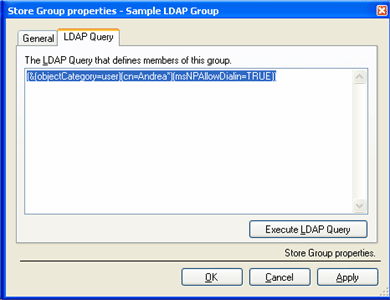
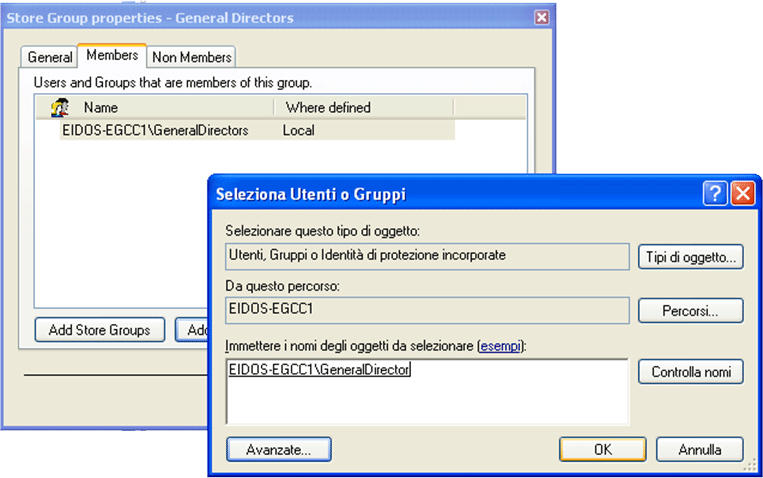

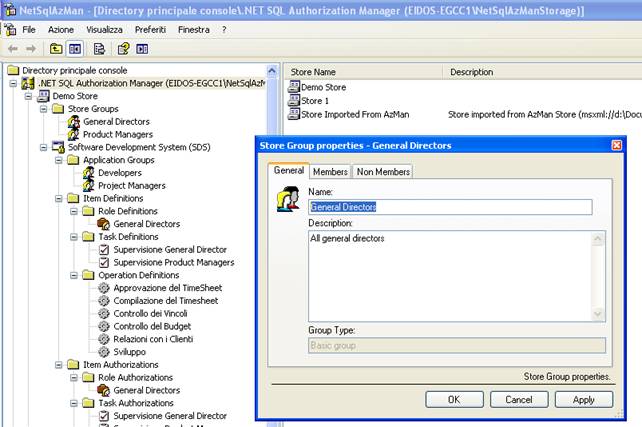


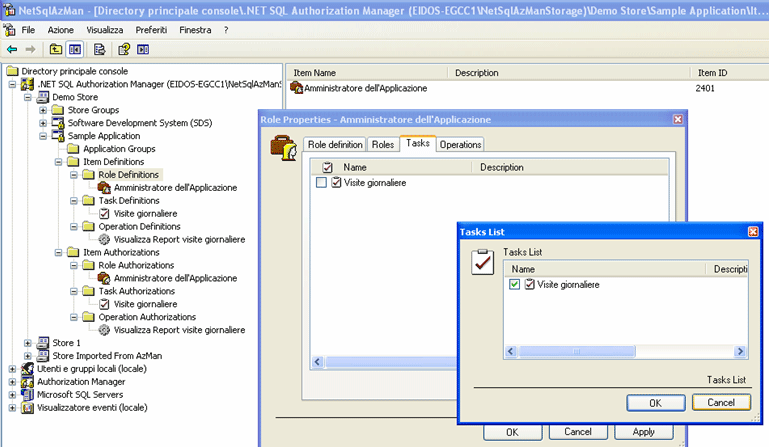
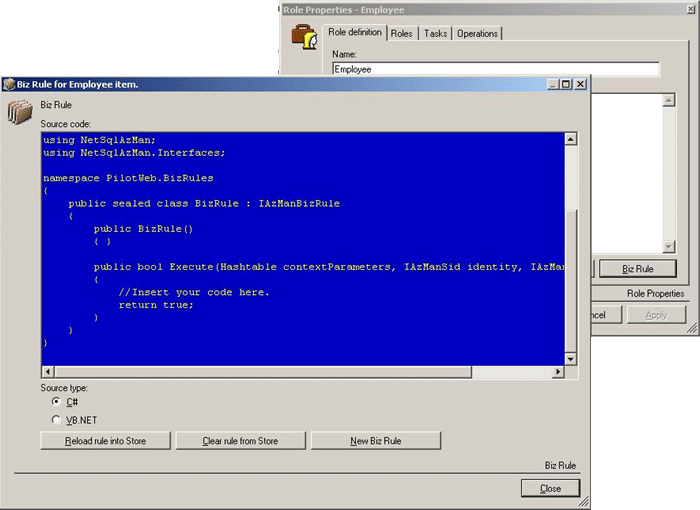



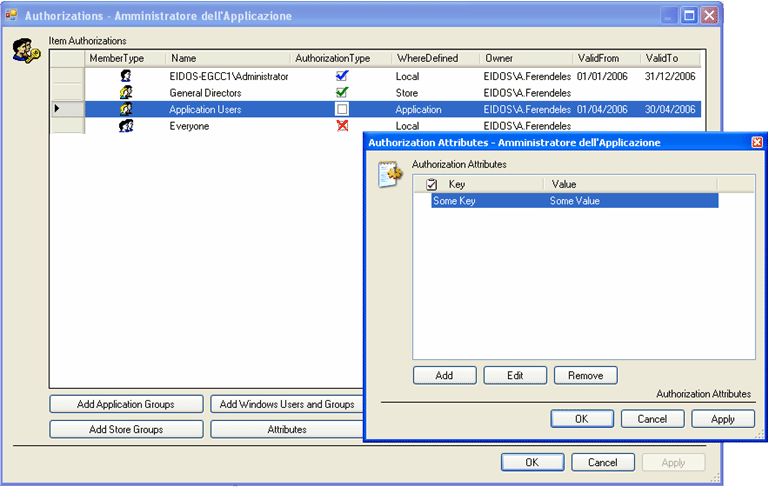

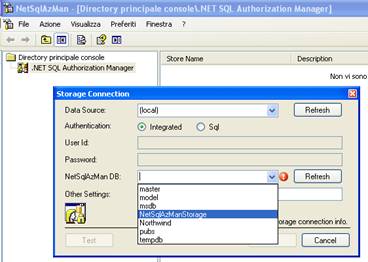
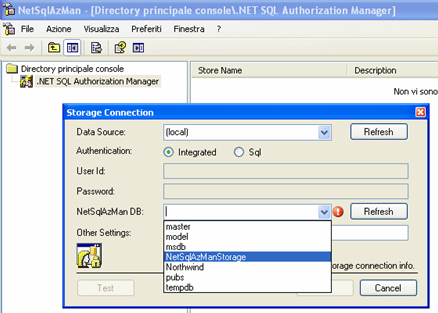
Comments